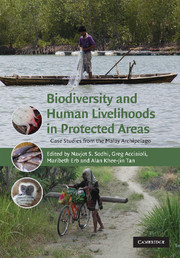Book contents
- Frontmatter
- Contents
- List of contributors
- Acknowledgements
- 1 General introduction
- Part I Conservation needs and priorities
- Part II Conservation with and against people(s)
- 11 Introduction to Part II
- 12 Collaboration, conservation, and community: a conversation between Suraya Afiff and Celia Lowe
- 13 Hands off, hands on: communities and the management of national parks in Indonesia
- 14 Conservation and conflict in Komodo National Park
- 15 Another way to live: developing a programme for local people around Tanjung Puting National Park, Central Kalimantan
- 16 For the people or for the trees? A case study of violence and conservation in Ruteng Nature Recreation Park
- 17 Seas of discontent: conflicting knowledge paradigms within Indonesia's marine environmental arena
- 18 Strategy and subjectivity in co-management of the Lore Lindu National Park (Central Sulawesi, Indonesia)
- 19 Indigenous peoples and parks in Malaysia: issues and questions
- 20 Protecting Chek Jawa: the politics of conservation and memory at the edge of a nation
- 21 Integrating conservation and community participation in protected-area development in Brunei Darussalam
- 22 Conclusion to Part II
- Part III Legal and governance frameworks for conservation
- 29 General conclusion
- Index
- References
22 - Conclusion to Part II
from Part II - Conservation with and against people(s)
Published online by Cambridge University Press: 12 November 2009
- Frontmatter
- Contents
- List of contributors
- Acknowledgements
- 1 General introduction
- Part I Conservation needs and priorities
- Part II Conservation with and against people(s)
- 11 Introduction to Part II
- 12 Collaboration, conservation, and community: a conversation between Suraya Afiff and Celia Lowe
- 13 Hands off, hands on: communities and the management of national parks in Indonesia
- 14 Conservation and conflict in Komodo National Park
- 15 Another way to live: developing a programme for local people around Tanjung Puting National Park, Central Kalimantan
- 16 For the people or for the trees? A case study of violence and conservation in Ruteng Nature Recreation Park
- 17 Seas of discontent: conflicting knowledge paradigms within Indonesia's marine environmental arena
- 18 Strategy and subjectivity in co-management of the Lore Lindu National Park (Central Sulawesi, Indonesia)
- 19 Indigenous peoples and parks in Malaysia: issues and questions
- 20 Protecting Chek Jawa: the politics of conservation and memory at the edge of a nation
- 21 Integrating conservation and community participation in protected-area development in Brunei Darussalam
- 22 Conclusion to Part II
- Part III Legal and governance frameworks for conservation
- 29 General conclusion
- Index
- References
Summary
The original title of the workshop from which these chapters were drawn was ‘Conservation for/by whom: Social Controversies & Cultural Contestations regarding National Parks and Reserves in the Malay Archipelago’. That main title was meant to interrogate not only issues of allocating agency – by whom – in the project of conservation in this region, but also issues in evaluating the hierarchy of beneficiaries – for whom – of conservation initiatives. It thus situated this project in the larger re-evaluation of environmental justice being carried out by academics, government officials and, of increasing importance, non-governmental organization (NGO) activists (Zerner 2000). As Lynch and Harwell (2002) point out, central to the project of creating a new paradigm of environmental justice is the recognition of community-based property rights, often (though not universally) defined by local custom or adat. Protected areas provide not only a conceptual space in which to think through these issues, as suggested by Afiff and Lowe in Chapter 12, but also a practical field in which the issues of resource rights are being daily negotiated, sometimes violently. In these contexts such terms as ‘collaboration’ and ‘participation’ now define the parameters of expectation guiding the conduct of these practical negotiations.
The chapters of this part both document the complexities and failures of collaboration in designing and managing protected areas and present parameters for envisioning possible changes that can raise the currently limited status of participation by local communities located in and around such areas to a more collaborative level (chapter 13).
- Type
- Chapter
- Information
- Biodiversity and Human Livelihoods in Protected AreasCase Studies from the Malay Archipelago, pp. 343 - 346Publisher: Cambridge University PressPrint publication year: 2007



